Multilayer Perceptron-Based Phenological and Radiometric Normalization for High-Resolution Satellite Imagery
Abstract
:1. Introduction
2. Materials and Methods
2.1. Study Site and Dataset
2.2. Methods
2.2.1. Radiometric Resolution Compression
2.2.2. Extraction of RCSS
2.2.3. Selection of the Spectral Index
2.2.4. Phenological Normalization Based on Multilayer Perceptron
2.2.5. Postprocessing
3. Results and Discussion
3.1. Comparisons of Normalization Results
3.2. Influence of the Radiometric Resolution
3.3. Influence of the Spectral Index
3.4. Additional Dataset
4. Conclusions
Author Contributions
Funding
Conflicts of Interest
References
- Zhong, C.; Xu, Q.; Li, B. Relative Radiometric Normalization for Multitemporal Remote Sensing Images by Hierarchical Regression. IEEE Geosci. Remote Sens. Lett. 2016, 13, 217–221. [Google Scholar] [CrossRef]
- Hong, G.; Zhang, Y.A. A Comparative Study on Radiometric Normalization Using High Resolution Satellite Images. Int. J. Remote Sens. 2008, 29, 425–438. [Google Scholar] [CrossRef]
- Zhou, H.; Liu, S.; He, J.; Wen, Q.; Song, L.; Ma, Y. A New Model for the Automatic Relative Radiometric Normalization of Multiple Images with Pseudo-Invariant Features. Int. J. Remote Sens. 2016, 37, 4554–4573. [Google Scholar] [CrossRef]
- Chen, X.; Vierling, L.; Deering, D. A Simple and Effective Radiometric Correction Method to Improve Landscape Change Detection Across Sensors and Across Time. Remote Sens. Environ. 2005, 98, 63–79. [Google Scholar] [CrossRef]
- Kim, D.S.; Pyeon, M.W.; Eo, Y.D.; Byun, Y.G.; Kim, Y.I. Automatic Pseudo-Invariant Feature Extraction for the Relative Radiometric Normalization of Hyperion Hyperspectral Images. GIsci. Remote Sens. 2012, 49, 755–773. [Google Scholar] [CrossRef]
- Song, C.; Woodcock, C.E.; Seto, K.C.; Lenny, M.P.; Macomber, S.A. Classification and Change Detection Using Landsat TM Data: When and How to Correct Atmospheric Effects? Remote Sens. Environ. 2001, 75, 230–244. [Google Scholar] [CrossRef]
- Du, Y.; Teillet, P.M.; Cihlar, J. Radiometric Normalization of Multitemporal High-Resolution Satellite Images with Quality Control for Land Cover Change Detection. Remote Sens. Environ. 2002, 82, 123–134. [Google Scholar] [CrossRef]
- Bao, N.; Lechner, A.M.; Fletcher, A.; Mellor, A.; Mulligan, D.; Bai, Z. Comparison of Relative Radiometric Normalization Methods Using Pseudo Invariant Features for Change Detection Studies in Rural and Urban Landscapes. J. Appl. Remote Sens. 2012, 6, 1–18. [Google Scholar] [CrossRef]
- Schroeder, T.A.; Cohen, W.B.; Song, C.; Canty, M.J.; Yang, J. Radiometric Correction of Multi-Temporal Landsat Data for Characterization of Early Successional Forest Patterns in Western Oregon. Remote Sens. Environ. 2006, 103, 16–26. [Google Scholar] [CrossRef]
- Hall, F.G.; Strebel, D.E.; Nickson, J.E.; Geoets, S.J. Radiometric Rectification: Toward a Common Radiometric Response Among Multidate, Multisensor Images. Remote Sens. Environ. 1991, 35, 11–27. [Google Scholar] [CrossRef]
- Liu, Y.; Yano, T.; Nishiyama, S.; Kimura, R. Radiometric Correction for Linear Change-Detection Technique: Analysis in Bi-Temporal Space. Int. J. Remote Sens. 2007, 28, 5143–5157. [Google Scholar] [CrossRef]
- Biday, S.G.; Bhosle, U. Radiometric Correction of Multitemporal Satellite Imagery. J. Comput. Sci. 2010, 6, 201–213. [Google Scholar] [CrossRef]
- Canty, M.J.; Nielsen, A.A.; Schmidt, M. Automatic Radiometric Normalization of Multitemporal Satellite Imagery. Remote Sens. Environ. 2004, 91, 441–451. [Google Scholar] [CrossRef]
- Vicente-Serrano, S.M.; Perez-Cabello, F. Assessment of Radiometric Correction Techniques in Analyzing Vegetation Variability and Change Using Time Series of Landsat Images. Remote Sens. Environ. 2008, 112, 3916–3934. [Google Scholar] [CrossRef]
- Yang, X.J.; Lo, C.P. Relative Radiometric Normalization Performance for Change Detection from Multi-Date Satellite Images. Photogramm. Eng. Remote Sens. 2000, 66, 967–980. [Google Scholar]
- Yuan, D.; Elvidge, C.D. Comparison of Relative Radiometric Normalization Techniques. ISPRS J. Photogramm. Remote Sens. 1996, 51, 117–126. [Google Scholar] [CrossRef]
- Chavez, P.S., Jr. An Improved Dark-Object Subtraction Technique for Atmospheric Scattering Correction of Multispectral Data. Remote Sens. Environ. 1988, 24, 459–479. [Google Scholar] [CrossRef]
- Schott, J.R.; Salvaggio, C.; Volhock, W.J. Radiometric Scene Normalization Using Pseudo-Invariant Features. Remote Sens. Environ. 1988, 26, 1–14. [Google Scholar] [CrossRef]
- Elvidge, C.D.; Yuan, D.; Weerackoon, R.D.; Lunetta, R.S. Relative Radiometric Normalization of Landsat Multispectral Scanner (MSS) Data Using an Automatic Scattergram Controlled Regression. Photogramm. Eng. Remote Sens. 1995, 61, 1255–1260. [Google Scholar]
- Ya’allah, S.M.; Saradjian, M.R. Automatic Normalization of Satellite Images Using Unchanged Pixels within Urban Areas. Inf. Fusion. 2005, 6, 235–241. [Google Scholar] [CrossRef]
- Sadeghi, V.; Ebadi, H.; Ahmadi, F.F. A New Model for Automatic Normalization of Multitemporal Satellite Images Using Artificial Neural Network and Mathematical Methods. Appl. Math. Modell. 2013, 37, 6437–6445. [Google Scholar] [CrossRef]
- Rahman, M.M.; Hay, G.J.; Couloigner, I.; Hemachandran, B.; Bailin, J. An Assessment of Polynomial Regression Techniques for the Relative Radiometric Normalization (RRN) of High-Resolution Multi-Temporal Airborne Thermal Infrared (TID) Imagery. Remote Sens. 2014, 6, 11810–11828. [Google Scholar] [CrossRef]
- Hang, R.; Liu, Q.; Song, H.; Sun, Y.; Zhu, F.; Pei, H. Graph Regularized Nonlinear Ridge Regression for Remote Data Analysis. IEEE J. Sel. Top. Appl. Earth Obs. Remote Sens. 2017, 10, 277–285. [Google Scholar] [CrossRef]
- Kim, H.J.; Seo, D.K.; Eo, Y.D.; Jeon, M.C.; Park, W.Y. Multi-Temporal Nonlinear Regression Method for Landsat Image Simulation. KSCE J. Civ. Eng. 2019, 23, 777–787. [Google Scholar] [CrossRef]
- Seo, D.K.; Kim, Y.H.; Eo, Y.D.; Park, W.Y.; Park, H.C. Generation of Radiometric, Phenological Normalized Images Based on Random Forest Regression for Change Detection. Remote Sens. 2017, 9, 1163. [Google Scholar] [CrossRef]
- Bai, Y.; Tang, P.; Hu, C. kCCA Transformation -Based Radiometric Normalization of Multi-Temporal Satellite Images. Remote Sens. 2018, 10, 432. [Google Scholar] [CrossRef]
- Zheng, Y.; Zhang, J.; van Genderen, J.L. Change Detection Approach to SAR and Optical Image Integration. Int. Arch. Photogramm. Remote Sens. 2008, XXXVII Pt B7, 1077–1084. [Google Scholar]
- Seo, D.K.; Kim, Y.H.; Eo, Y.D.; Lee, M.H.; Park, W.Y. Fusion of SAR and Multispectral Images Using Random Forest Regression for Change Detection. ISPRS Int. J. Geo-Inf. 2018, 7, 401. [Google Scholar] [CrossRef]
- Ji, C.Y. Land-Use Classification of Remotely Sensed Data Using Kohonen Self-Organizing Feature Map Neural Network. Photogramm. Eng. Remote Sens. 2000, 66, 1451–1460. [Google Scholar]
- Hu, X.; Weng, Q. Estimating Impervious Surfaces from Medium Spatial Resolution Imagery Using the Self-Organizing Map and Multi-Layer Perceptron Neural Networks. Remote Sens. Environ. 2009, 113, 2089–2102. [Google Scholar] [CrossRef]
- Taravat, A.; Proud, S.; Peronaci, S.; Frate, F.D.; Oppelt, N. Multilayer Perceptron Neural Networks Model for Meteosat Second Generation SEVIRI Daytime Cloud Masking. Remote Sens. 2015, 7, 1529–1539. [Google Scholar] [CrossRef] [Green Version]
- Thakur, A.; Mishra, D. Hyperspectral Image Classification Using Multilayer Perception Neural Network & Functional Link ANN. In Proceedings of the 2017 7th international Conference on Cloud Computing, Data Science & Engineering-Confluence, Noida, India, 12–13 January 2017; pp. 639–642. [Google Scholar]
- Patra, S.; Ghosh, S.; Ghosh, A. Change Detection of Remote Sensing Images with Semi-Supervised Multilayer Perceptron. Fundam. Inf. 2008, 84, 429–442. [Google Scholar]
- Jiang, W.; He, G.; Long, T.; Ni, Y.; Liu, H.; Peng, Y.; Lv, K.; Wang, G. Multilayer Perceptron Neural Network for Surface Water Extraction in Landsat 8 OLI Satellite Images. Remote Sens. 2018, 10, 755. [Google Scholar] [CrossRef]
- Verde, N.; Mallinis, G.; Tsakiri-Strati, M.; Georgiadis, C.; Patias, P. Assessment of Radiometric Resolution Impact on Remote Sensing Data Classification Accuracy. Remote Sens. 2018, 10, 1267. [Google Scholar] [CrossRef]
- Miyoshi, G.T.; Imai, N.N.; Tommaselli, A.M.G.; Honkavaara, E. Impact of Reduction of Radiometric Resolution in Hyperspectral Images Acquired over Forest Field. Int. Arch. Photogramm. Remote Sens. Spat. Inf. Sci. 2018, XLII-1, 301–305. [Google Scholar] [CrossRef]
- Alonso, C.; Tarquis, A.M.; Zuniga, I.; Benito, R.M. Spatial and Radiometric Characterization of Multi-Spectrum Satellite Images through Multi-Fractal Analysis. Nonlinear Process. Geophys. 2017, 24, 141–155. [Google Scholar] [CrossRef]
- Seo, D.K.; Kim, Y.H.; Eo, Y.D.; Park, W.Y. Learning-Based Colorization of Grayscale Aerial Images Using Random Forest Regression. Appl. Sci. 2018, 7, 1269. [Google Scholar] [CrossRef]
- Seo, D.K.; Eo, Y.D. Relative Radiometric Normalization for High-Resolution Satellite Imagery Based on Multilayer Perceptron. J. Korean Soc. Surv. Geod. Photogramm Cartogr. 2018, 36, 515–523. [Google Scholar] [CrossRef]
- Motohka, T.; Nasahara, K.N.; Oguma, H.; Tsuchida, S. Applicability of Green-Red Vegetation Index for Remote Sensing of Vegetation Phenology. Remote Sens. 2010, 2, 2369–2387. [Google Scholar] [CrossRef] [Green Version]
- Xue, J.; Su, B. Significant Remote Sensing Vegetation Indices: A Review of Developments and Applications. J. Sens. 2017, 2017, 1353691. [Google Scholar] [CrossRef]
- Carvalho, O.A.D.; Guimaraes, R.F.; Silva, N.C.; Gillespie, A.R.; Gomes, R.A.T.; Silva, C.E.; Carvalho, A.P.F.D. Radiometric Normalization of Temporal Images Combining Automatic Detection of Pseudo-Invariant Features from the Distance and Similarity Spectral Measures, Density Scatterplot Analysis and Robust Regression. Remote Sens. 2013, 5, 2763–2794. [Google Scholar] [CrossRef]
- Yang, W.; Wang, S.; Zhao, X.; Zhang, J.; Feng, J. Greenness Identification Based on HSV Decision Tree. Inf. Process. Agric. 2015, 2, 149–160. [Google Scholar] [CrossRef]
- Sonnentag, O.; Hufkens, K.; Teshera-Sterne, C.; Young, A.M.; Friedl, M.; Braswell, B.H.; Millinam, T.; O’Keefe, J.; Richardson, A.D. Digital Repeat Photography for Phenological Research in Forest Ecosystems. Agric. For. Meteorol. 2012, 152, 159–177. [Google Scholar] [CrossRef]
- Larrinaga, A.R.; Brotons, L. Greenness Indices from a Low-Cost UAV Imagery as Tools for Monitoring Post-Fire Recovery. Drones 2019, 3, 6. [Google Scholar] [CrossRef]
- Kwak, N.J.; Choi, C.H. Input Feature Selection for Classification Problems. IEEE Trans. Neural Netw. 2002, 13, 143–159. [Google Scholar] [CrossRef]
- Koo, J.H.; Seo, D.K.; Eo, Y.D. Variable Importance Assessment for Colorization of Grayscale Aerial Images Based on Random Forest, Adaptive Boosting and Stochastic Gradient Boosting. Disaster Adv. 2018, 11, 22–29. [Google Scholar]
- Reifman, M.M.; Feldman, E.E. Multilayer Perceptron for Nonlinear Programming. Comput. Oper. Res. 2002, 29, 1237–1250. [Google Scholar] [CrossRef]
- Rodriguez-Galiano, V.; Sanchez-Castillo, M.; Chica-Olmo, M.; Chica-Rivas, M. Machine Learning Predictive Models for Mineral Prospectivity: An Evaluation of Neural Networks, Random Forest, Regression Trees and Support Vector Machines. Ore Geol. Rev. 2015, 71, 804–818. [Google Scholar] [CrossRef]
- Karsoliya, S. Approximating Number of Hidden Layer Neurons in Multiple Hidden Layer BPNN Architecture. Int. J. Eng. Trends Technol. 2012, 3, 714–717. [Google Scholar]
- Sumsion, G.R.; Bradshaw, M.S.; Hill, K.T.; Pinto, L.D.G.; Piccolo, S.R. Remote Sensing Tree Classification with a Multilayer Perceptron. PeerJ 2019, 7, 1–13. [Google Scholar] [CrossRef]
- Hermel, E.H.; Ruefenacht, B. A Comparison of Radiometric Normalization Methods When Filling Cloud Gaps in Landsat Imagery. Can. J. Remote Sen. 2007, 33, 325–340. [Google Scholar] [CrossRef]
- Yeom, J.M.; Ko, J.H.; Hwang, J.S.; Lee, C.S.; Chou, C.U.; Jeong, S.T. Updating Absolute Radiometric Characteristics for KOMPSAT-3 and KOMPSAT-3A Multispectral Imaging Sensors Using Well-Characterized Pseudo-Invariant Tarps and Microtops II. Remote Sens. 2018, 10, 697. [Google Scholar] [CrossRef]

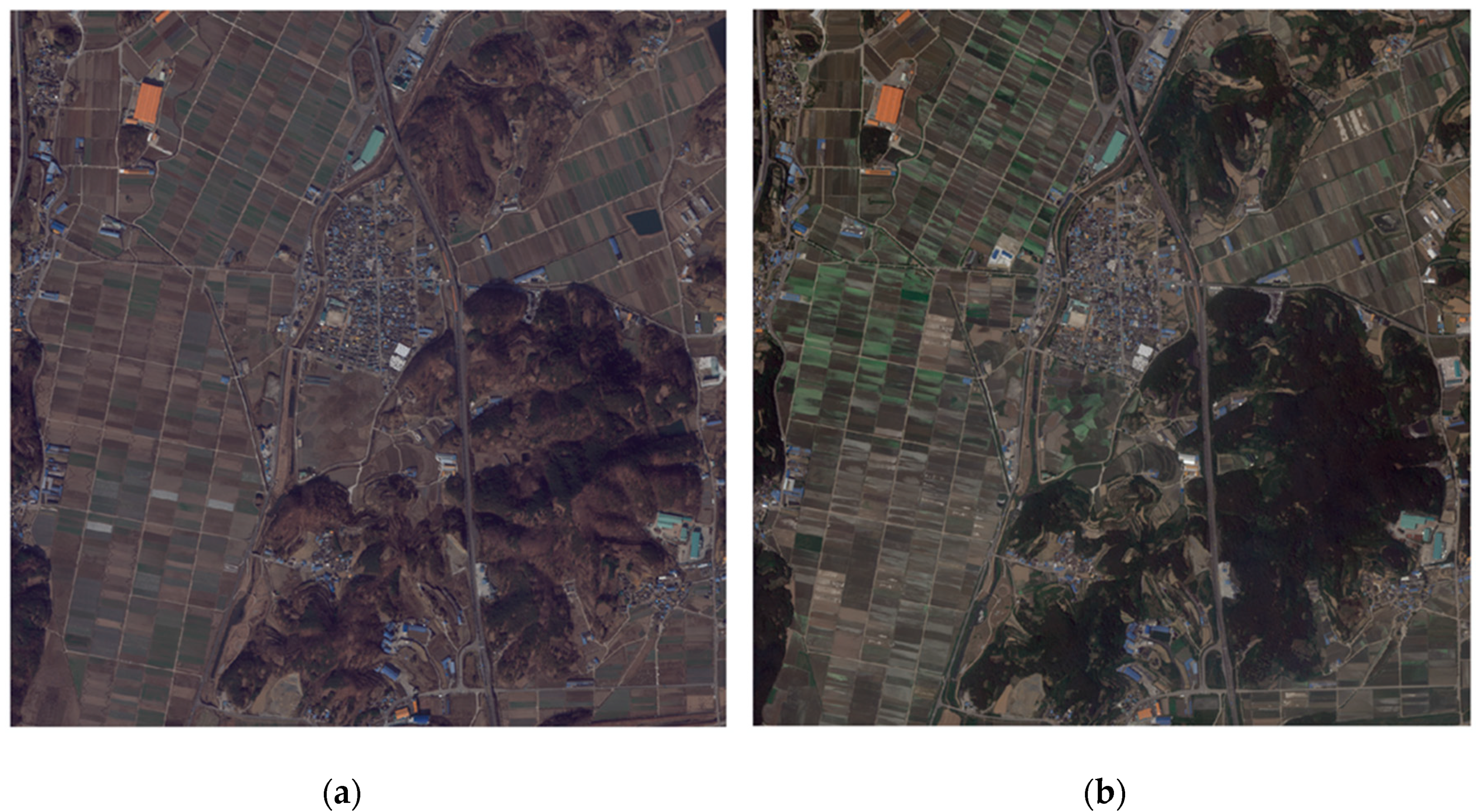
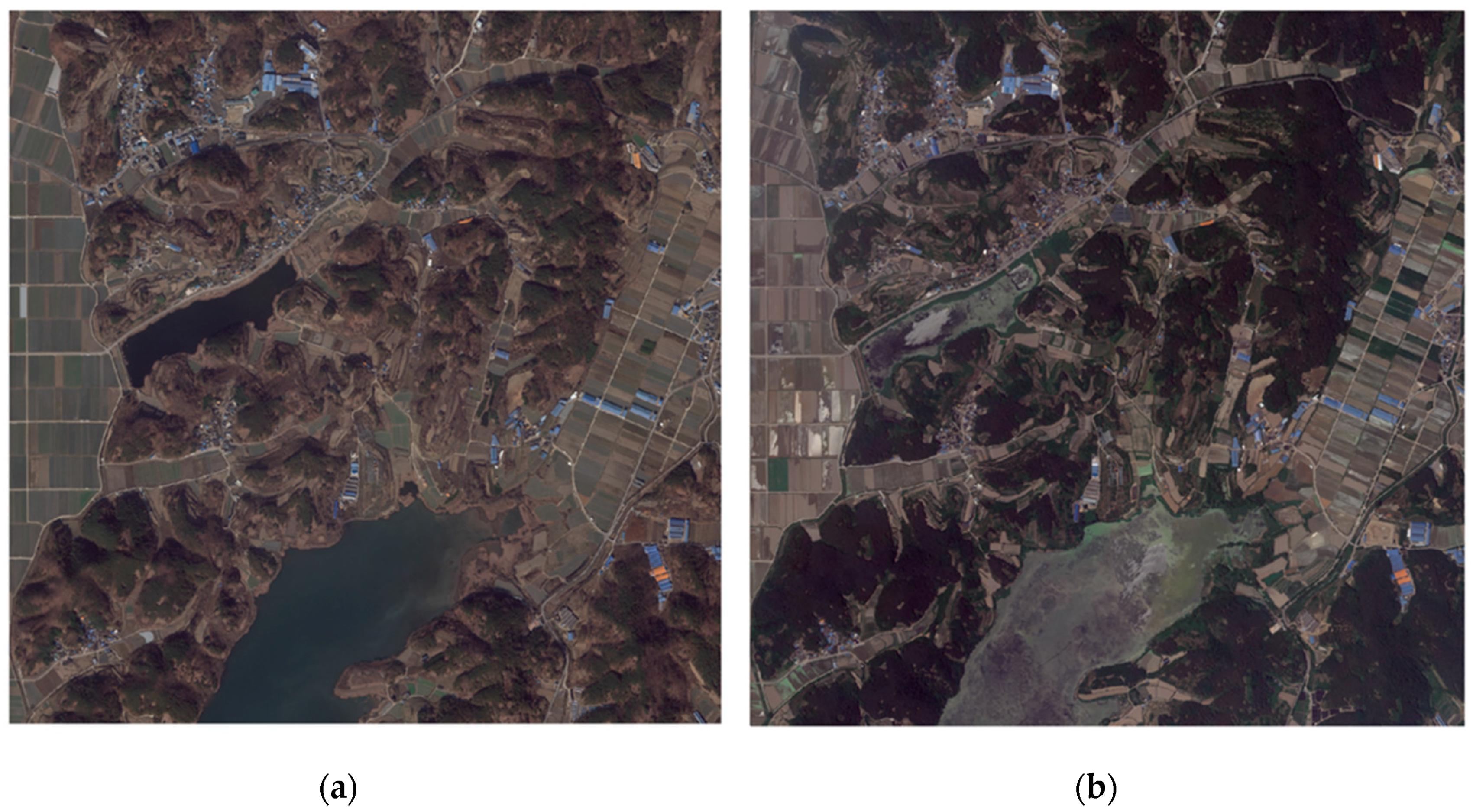

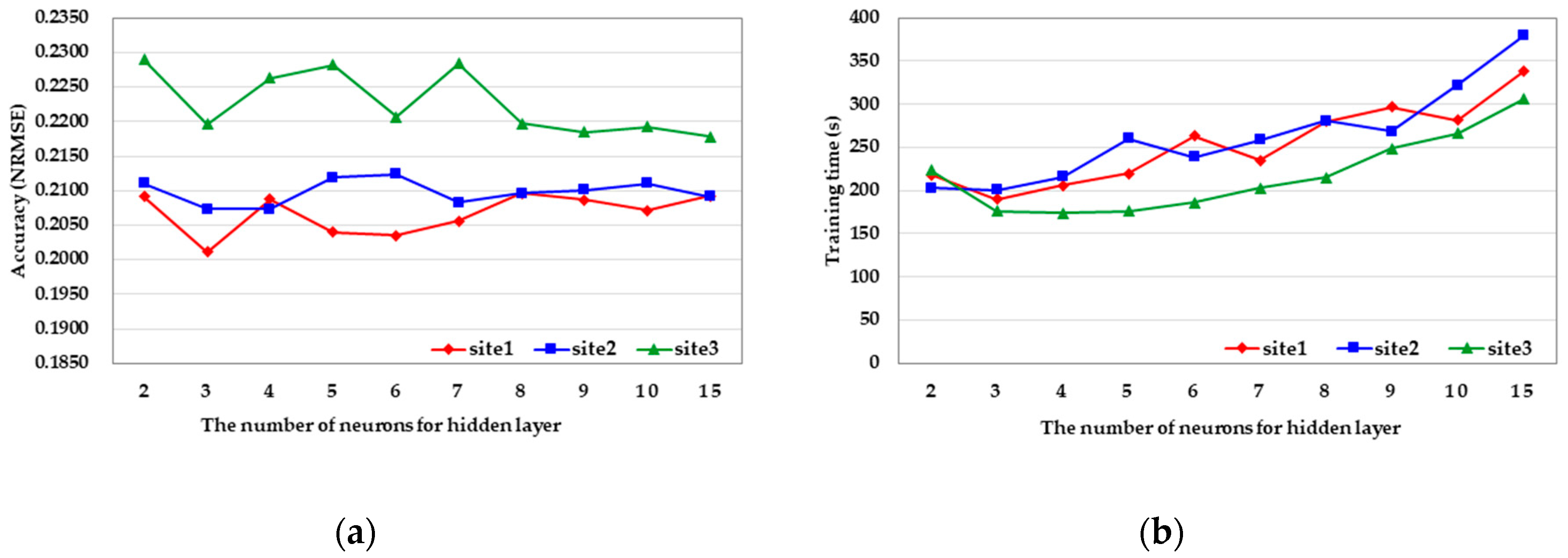

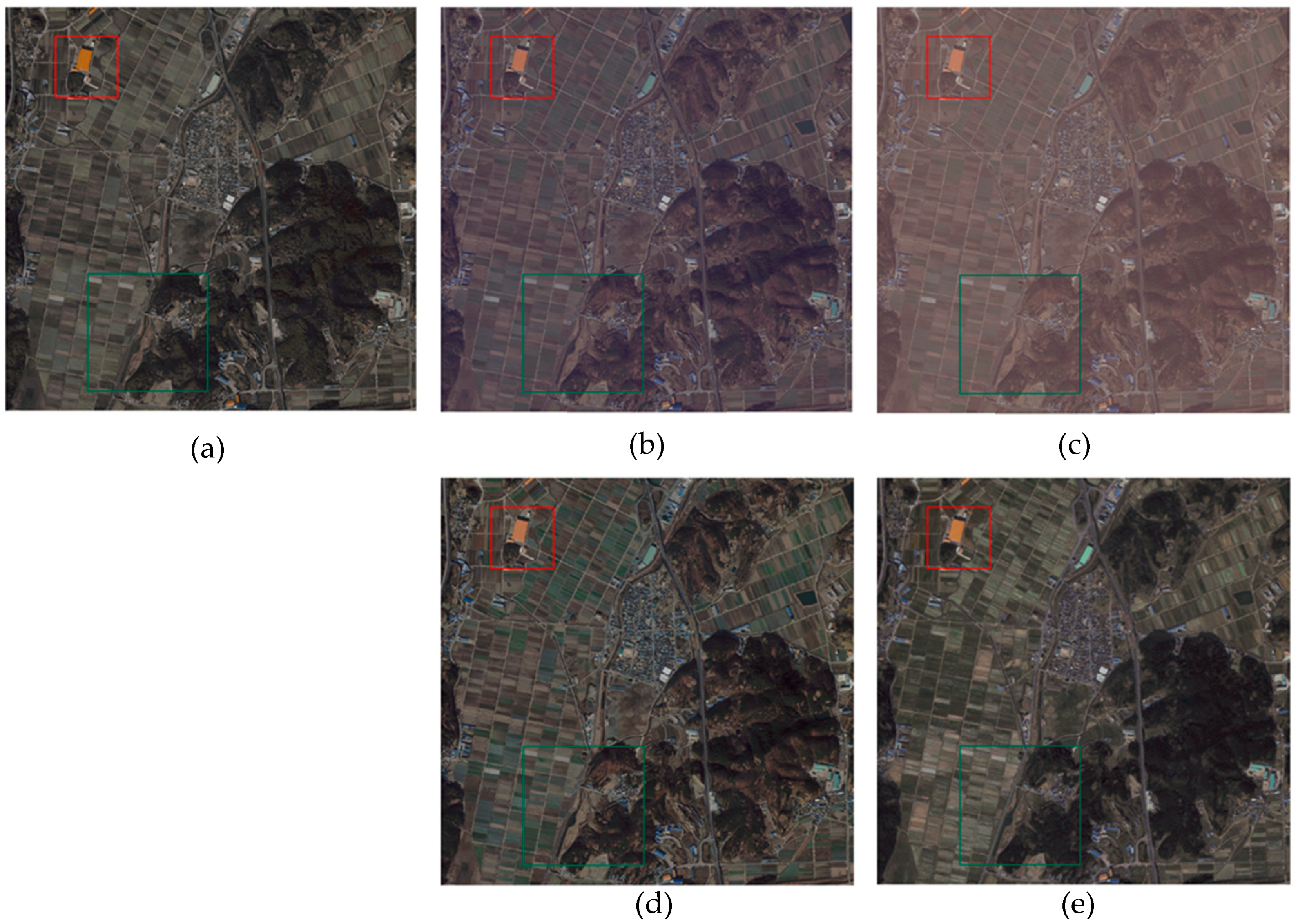
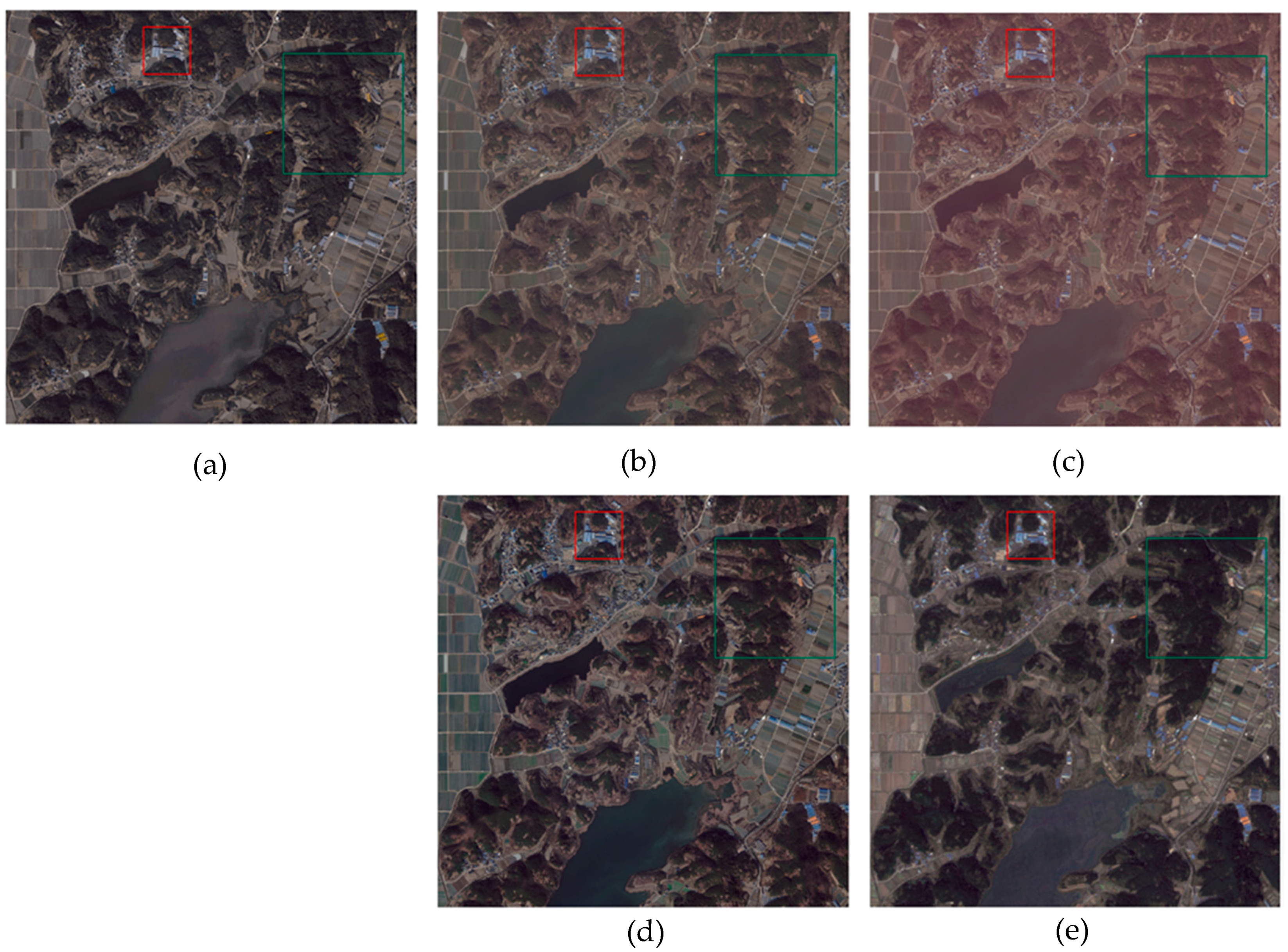

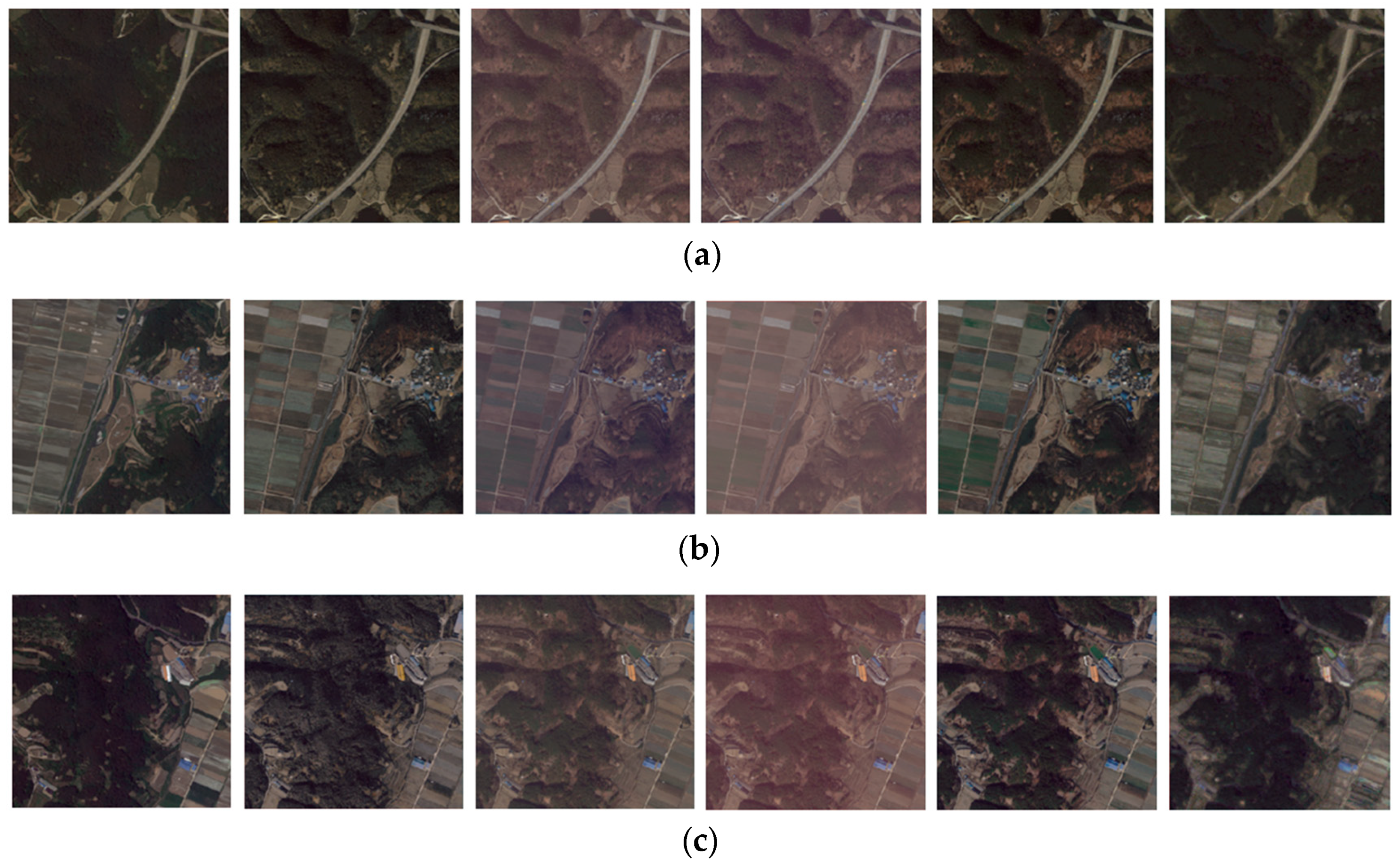


| Sensor | KOMPSAT-3A (subject image) | KOMPSAT-3A (reference image) |
| Location | Changnyeong-gun (Korea) | |
| Date | 30 Oct. 2015 | 18 Jun. 2016 |
| Spatial resolution (m) | 2.2 (multispectral) | |
| Spectral resolution (nm) | Blue: 450–510 Green: 520–600 Red: 630–690 Near-infrared: 760–900 | |
| Radiometric resolution | 14-bit | |
| Image size (pixels) | 1200 × 1200 | |
| Hyperparameter | Value |
|---|---|
| Number of input variables | 2 |
| Number of hidden layers | 1 |
| Number of neurons in the hidden layer | 3 |
| Number of neurons in the output layer | 1 |
| Activation function | ReLU |
| Loss function | Squared error |
| Optimizer | ADAM |
| Learning rate | 10−4 |
| Training epochs | 200 |
| Site | Method | Band 1 | Band 2 | Band 3 | Band 4 | Average |
|---|---|---|---|---|---|---|
| Site1 | Subject image | 0.3948 | 0.5077 | 0.5672 | 0.6888 | 0.5396 |
| Proposed method | 0.1440 | 0.1987 | 0.3073 | 0.1545 | 0.2011 | |
| MS | 0.1820 | 0.2694 | 0.438 | 0.4924 | 0.3455 | |
| NC | 0.1758 | 0.2530 | 0.4033 | 0.4527 | 0.3212 | |
| RF | 0.1497 | 0.2187 | 0.3406 | 0.3919 | 0.2752 | |
| Histogram matching | 0.1886 | 0.2720 | 0.4522 | 0.4108 | 0.3309 | |
| Site2 | Subject image | 0.4169 | 0.5268 | 0.5609 | 0.6834 | 0.5470 |
| Proposed method | 0.1248 | 0.1696 | 0.2579 | 0.2771 | 0.2074 | |
| MS | 0.1763 | 0.2740 | 0.4008 | 0.4967 | 0.3370 | |
| NC | 0.1576 | 0.2234 | 0.3414 | 0.4911 | 0.3034 | |
| RF | 0.1663 | 0.2397 | 0.3556 | 0.4217 | 0.2958 | |
| Histogram matching | 0.178 | 0.2558 | 0.401 | 0.4386 | 0.3184 | |
| Site3 | Subject image | 0.3813 | 0.5164 | 0.5946 | 0.7003 | 0.5482 |
| Proposed method | 0.1469 | 0.2093 | 0.3315 | 0.1909 | 0.2197 | |
| MS | 0.1875 | 0.2831 | 0.4740 | 0.5219 | 0.3666 | |
| NC | 0.1963 | 0.2614 | 0.4207 | 0.3628 | 0.3053 | |
| RF | 0.1492 | 0.2100 | 0.3261 | 0.3546 | 0.2600 | |
| Histogram matching | 0.1965 | 0.2942 | 0.4962 | 0.3685 | 0.3389 |
| Site | Method | Band 1 | Band 2 | Band 3 | Band 4 |
|---|---|---|---|---|---|
| Site 1 | ExG | 0.1440 | 0.2027 | 0.3373 | 0.1545 |
| ExGR | 0.1459 | 0.2044 | 0.3073 | 0.1579 | |
| VEG | 0.1464 | 0.2063 | 0.3355 | 0.1576 | |
| CIVE | 0.1460 | 0.2048 | 0.3316 | 0.1578 | |
| COM | 0.1462 | 0.1987 | 0.3326 | 0.1570 | |
| Site 2 | ExG | 0.1248 | 0.1747 | 0.2730 | 0.2771 |
| ExGR | 0.1289 | 0.1733 | 0.2579 | 0.2842 | |
| VEG | 0.1294 | 0.1762 | 0.2702 | 0.2848 | |
| CIVE | 0.1285 | 0.1703 | 0.2686 | 0.2843 | |
| COM | 0.1262 | 0.1696 | 0.2635 | 0.2848 | |
| Site 3 | ExG | 0.1469 | 0.2187 | 0.3600 | 0.1909 |
| ExGR | 0.1493 | 0.2171 | 0.3315 | 0.1950 | |
| VEG | 0.1521 | 0.2222 | 0.3728 | 0.1949 | |
| CIVE | 0.1489 | 0.2169 | 0.3586 | 0.1950 | |
| COM | 0.1494 | 0.2093 | 0.3621 | 0.1949 |
| Site | Method | Band 1 | Band 2 | Band 3 | Band 4 | Average |
|---|---|---|---|---|---|---|
| Seoul | Proposed method | 0.1305 | 0.1773 | 0.2639 | 0.1874 | 0.1898 |
© 2019 by the authors. Licensee MDPI, Basel, Switzerland. This article is an open access article distributed under the terms and conditions of the Creative Commons Attribution (CC BY) license (http://creativecommons.org/licenses/by/4.0/).
Share and Cite
Seo, D.K.; Eo, Y.D. Multilayer Perceptron-Based Phenological and Radiometric Normalization for High-Resolution Satellite Imagery. Appl. Sci. 2019, 9, 4543. https://doi.org/10.3390/app9214543
Seo DK, Eo YD. Multilayer Perceptron-Based Phenological and Radiometric Normalization for High-Resolution Satellite Imagery. Applied Sciences. 2019; 9(21):4543. https://doi.org/10.3390/app9214543
Chicago/Turabian StyleSeo, Dae Kyo, and Yang Dam Eo. 2019. "Multilayer Perceptron-Based Phenological and Radiometric Normalization for High-Resolution Satellite Imagery" Applied Sciences 9, no. 21: 4543. https://doi.org/10.3390/app9214543
APA StyleSeo, D. K., & Eo, Y. D. (2019). Multilayer Perceptron-Based Phenological and Radiometric Normalization for High-Resolution Satellite Imagery. Applied Sciences, 9(21), 4543. https://doi.org/10.3390/app9214543






